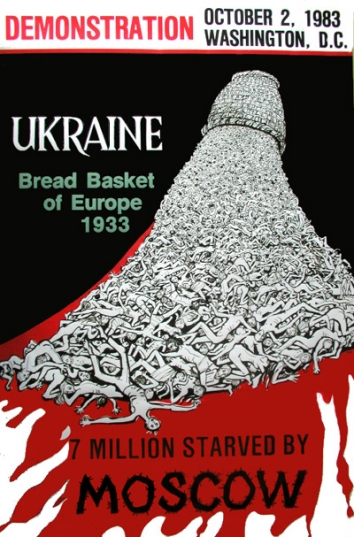Featured Galleries USUBC COLLECTION OF OVER 160 UKRAINE HISTORIC NEWS PHOTOGRAPHS 1918-1997
 Holodomor Posters
Holodomor Posters

UKRAINE - MACROECONOMIC SITUATION - NOVEMBER 2016
 ANALYTICAL REPORT: by Oleg Ustenko, Djulia Segura, Valentyn Povroznyuk, Edilberto L. Segura
ANALYTICAL REPORT: by Oleg Ustenko, Djulia Segura, Valentyn Povroznyuk, Edilberto L. Segura
SigmaBleyzer private equity investment management firm & The Bleyzer Foundation (TBF), Kyiv, Ukraine
LINK: UKRAINE_MONTHLY_ECONOMIC_REPORT_NOVEMBER_2016_PDF.PDF
Published by U.S.-Ukraine Business Council (USUBC),
Washington, D.C., Mon, Dec 19, 2016
WASHINGTON, D.C. - The "Ukraine Macroeconomic Situation – November 2016" analytical report is found below and as an attachment to this communication. The monthly macroeconomic situation report is prepared by the SigmaBleyzer private equity investment management firm, www.SigmaBleyzer.com, and The Bleyzer Foundation (TBF), www.BleyzerFoundation.org, Kyiv, Ukraine, who are members of the U.S.-Ukraine Business Council (USUBC), http://www.USUBC.org.
Executive Summary:
- The last two meetings of Foreign Ministers of Ukraine, Germany, France, and Russia in Minsk on November 29th and by Skype on December 7th did not advance the resolution of the military conflict in Donbas. Nevertheless, the intensity of daily attacks against Ukrainian army from separatists decreased to around 30 per day in November compared to an average of 50 per day in October. In December, however, hostilities intensified again.
- Ukraine's reform agenda continues to move forward, though at a slow pace. In November, the priorities of reform initiatives were concentrated in the areas of deregulation and fighting corruption. In particular, on November 3rd, the Ukrainian Parliament adopted a series of progressive laws, which annulled 367 resolutions and acts that were considered business "unfriendly". The most recent development in fighting corruption is concentrated in the implementation of the second stage of electronic income declaration, under which all government officials must declare their assets and incomes. The deadline for this stage is the end of 2016.
- Ukraine's GDP grew by 1.8% yoy in the third quarter of 2016. High frequency data show that the economy continued to recover in October 2016. In fact, in October 2016 agriculture output increased by 12.4% yoy. The construction sector also performed well, with construction output increasing by 7.8% yoy in October. The transportation sector also grew during the month, but at a lower rate of 0.4% yoy. Industrial production output index increased by 0.8% yoy during the month and retail trade turnover increased by 0.9% yoy.
- Significant acceleration in the growth of state budget revenues and simultaneous deceleration in the growth of state budget expenditures led to a state budget surplus of UAH 3.1 billion in October. Local budgets were also executed with surpluses. As a result, the deficit of the state budget from the beginning of the year declined to UAH 60.3 billion and the consolidated budget deficit declined to UAH 26.9 billion (1.3% of period GDP).
- In October, growth in consumer prices accelerated to 12.4% yoy, due principally to increases in administratively regulated prices and tariffs. In particular, the housing and utilities price index increased to 44.4% yoy, with the biggest price increases in heating tariffs (which grew by 82.1% yoy) and gas prices (which grew by 42.0% yoy).
- The UAH/USD exchange rate was mostly stable in November. We leave our forecast for the exchange rate unchanged at around 26.0 UAH/USD by the end of the year
- A surplus in the financial account of the balance-of-payments covered the deficit in the current account. As of November 2016, the level of international reserves stood at USD 15.3 billion (3.9 months of imports.)
|
Main Macroeconomic Indicators |
2011 |
2012 |
2013 |
2014 |
2015 |
2016f |
2017f |
|
GDP, USD billion |
163 |
173 |
180 |
130 |
98 |
95 |
100 |
|
Real GDP Growth, % yoy |
5.5 |
0.2 |
0.0 |
-6.6 |
-9.9 |
1.5 |
3.0 |
|
Fiscal Balance (incl. Naftogaz & Pension Fund), % of GDP |
-4.3 |
-5.5 |
-6.5 |
-11.7 |
-8.0 |
-4.0 |
-3.0 |
|
Public Debt, External and Domestic, % of GDP |
36.4 |
36.6 |
40.4 |
69.4 |
79.4 |
84.4 |
82.0 |
|
Consumer Inflation, eop, % yoy |
4.6 |
-0.2 |
0.5 |
24.9 |
43.3 |
12.0 |
10.0 |
|
Hryvnia Exchange Rate per USD, eop |
8.0 |
8.1 |
8.2 |
15.8 |
24.0 |
26.0 |
28.0 |
|
Current Account Balance, % of GDP |
-6.3 |
-8.3 |
-9.0 |
-4.1 |
0 |
-3.0 |
-2.0 |
|
FDI, Net Annual Inflow, USD billion |
7.0 |
7.2 |
4.1 |
0.3 |
2.3 |
3.0 |
3.0 |
|
International Reserves, USD billion |
31.8 |
24.5 |
20.4 |
7.5 |
13.3 |
16.0 |
18.0 |
|
Public External Debt, USD billion |
33.3 |
32.1 |
31.7 |
34.9 |
47.0 |
55.0 |
60.0 |
|
Private External Debt, USD billion |
84.6 |
92.0 |
99.2 |
82.0 |
70.0 |
65.0 |
62.0 |
Political and Reform Developments
The last two meetings of Foreign Ministers of Ukraine, Germany, France, and Russia in Minsk on November 29th and by Skype on December 7th did not advance the resolution of the military conflict in Donbas. Nevertheless, the intensity of daily attacks against the Ukrainian army from separatists decreased to around 30 per day in November compared to an average of 50 per day in October. In December, however, hostilities intensified again. The conflict has already destroyed the major part of the regional economy. It is estimated that GDP in the areas under separatist control is only about 30% to 40% of the pre-conflict GDP, with economic activities going on mainly in agriculture. Humanitarian problems (i.e., water and food supply, heating of houses, medical care, etc.) are
unresolved. Around 2.0 million citizens were forced to leave the conflict zone, with about 2.5 million people still remaining in the area. On a positive note, all parties agreed to develop a road map with concrete steps to initiate the release of Donbas hostages.
Ukraine's reform agenda continues to move forward although at a slow pace. In November, the main priorities of reform initiatives were concentrated in the areas of deregulation and fighting corruption. In particular, on November 3, the Ukrainian Parliament adopted a series of progressive laws, which annulled 367 resolutions and acts. These regulations were considered as “business unfriendly”. The decision was prepared and backed by representatives of businesses and the expert community. In addition, the Parliament imposed an embargo on any inspections until the end of 2017, which should positively affect businesses and stimulate economic growth in the country.
Even though the local press reports innumerable cases of corruption incurred by low and middle-level government officials, the lion share of these cases are not brought to the courts. The efforts in fighting corruption are concentrated in the implementation of the second stage of electronic income declaration. In the first stage, income declarations were submitted only by top government officials. In the second stage, the rest of government officials must declare their assets and incomes. The deadline for this stage is the end of 2016. This stage will be followed by investigations of the National Anticorruption Agency, which will check the information submitted by all government officials on both stages. The Agency expects to finalize its work before April 2017. If investigations of the Agency discover violations, the correspondent cases would be transferred to the Anticorruption Court. On a negative side, the process of forming Anticorruption courts is not yet finalized. However, the process is under scrutiny of the Ukrainian civil society and the country’s international partners.
The recent IMF mission left Ukraine on November 12th. In its final statement, the mission re- confirmed that the country has made significant progress in delivering the reform agenda. However, the IMF stated that the authorities need some more time to implement policies to ensure medium-term fiscal sustainability—including adoption of the 2017 budget consistent with program targets— safeguard financial and banking sector stability, and tackle corruption including judiciary and court system reform. It is not expected that any funds will be released during 2016.
In November, Fitch Rating Agency upgraded Ukraine's government bonds from the 'CCC' to 'B-' level. The agency assigned a “stable” outlook for the country. The upgrade was based on the progress reached in the overall macroeconomic conditions of the country. In particular, the agency emphasized a number of positive developments, including revival of economic growth, deceleration of inflation, increased foreign exchange reserves and decrease in budget deficits.
To read more please open the PDF : UKRAINE_MONTHLY_ECONOMIC_REPORT_NOVEMBER_2016_PDF.PDF











